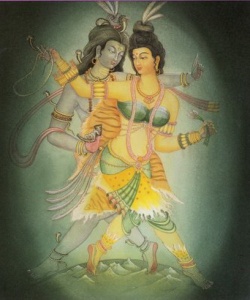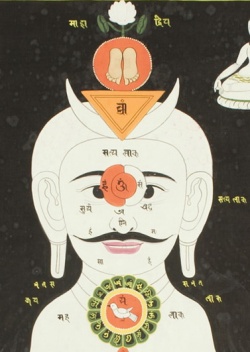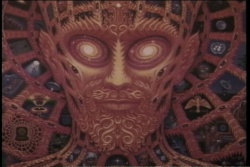The explosion of sexuality: Vajrayana Buddhism
All Tantras are structurally similar; they all include the transformation of erotic Love into spiritual and worldly Power. [1] The essence of the entire Doctrine is, however, encapsulated in the so-called Kalachakra Tantra, or “Time Tantra”, the analysis of which is our central objective. It differs from the remaining Tantra teachings in both its Power-political intentions and its eschatological visions. It is — we would like to hypothesize in advance — the instrument of a complicated metapolitics which attempts to influence World events via the use of symbols and rites rather than the tools of realpolitik. The “Time Tantra” is the particular secret Doctrine which primarily determines the ritual existence of the living Fourteenth Dalai Lama, and the “God-king’s” spiritual World politics can be understood through a Knowledge of it alone.
The Kalachakra Tantra marks the close of the creative phase of Vajrayana’s history in the tenth century. No further fundamental Tantra texts have been conceived since, whilst countless commentaries upon the existing texts have been written, up until the present day. We must thus regard the “Time Tantra” as the culmination of and finale to Buddhist Tantrism. The other tantric texts which we cite in this study (especially the Guhyasamaya Tantra, the Hevajra Tantra and the Candamaharosana Tantra), are primarily drawn upon in order to decipher the Kalachakra Tantra.
At first glance the sexual roles seem to have changed completely in Tantric Buddhism (Vajrayana). The contempt for the World of the senses and degradation of women in Hinayana, the asexuality and Compassion for women in Mahayana, appear to have been turned into their opposites here. It all but amounts to an explosion of sexuality, and the idea that sexual Love harbors the secret of the Universe becomes a spectacular dogma. The erotic encounter between man and woman is granted a mystical aura, an authority and Power completely denied it in the preceding Buddhist eras.
With neither timidity nor dread Buddhist Monks now speak about “venerating women”, “praising women”, or “service to the female partner”. In Vajrayana, every female being experiences exaltation rather than humiliation; instead of contempt she enjoys, at first glance, respect and high esteem. In the Candamaharosana Tantra the glorification of the feminine knows no bounds: “Women are Heaven; women are Dharma; ... women are Buddha; women are The Sangha; women are the perfection of Wisdom”(George, 1974, p. 82).
The spectrum of erotic relations between the sexes ranges from the most sublime professions of courtly Love to the coarsest pornography. Starting from the highest rung of this ladder, the Monks worship the feminine as “perfected Wisdom” (prajnaparamita), “Wisdom consort” (Prajna), or “woman of Knowledge” (vidya). This spiritualization of the woman corresponds, with some variation, to the Christian cults of Mary and Sophia. Just as Christ revered the “Mother of God”, the Tantric Buddhist bows down before the woman as the “Mother of all Buddhas”, the “Mother of the Universe”, the “Genetrix”, the “Sister”, and as the “Female Teacher”(Herrmann-Pfand, 1992, pp. 62, 60, 76).
As far as sensual relationships with women are concerned, these are divided into four categories: “laughing, regarding, embracing, and union”. These four types of erotic communication Form the pattern for a corresponding classification of tantric exercises. The texts of the Kriya Tantra address the category of laughter, those of the Carya Tantra that of the look, the Yoga Tantra considers the embrace, and in the writings of the Anuttara Tantra (the Highest Tantra) sexual union is addressed. These practices stand in a hierarchical relation to one another, with laughter at the lowest level and the tantric act of Love at the highest.
In Vajrayana the latter becomes a religious concern of the highest order, the sine qua non of Enlightenment. Although Homosexuality was not uncommon in Buddhist Monasteries and was occasionally even regarded as a Virtue, the “great bliss of Liberation” was fundamentally conceived of as the union of man and woman and accordingly portrayed in cultic images.
However, both tantric partners encounter one another not as two natural people, but rather as two deities. “The man (sees) the woman as a goddess, the woman (sees) the man as a God. By joining the diamond scepter [[[Wikipedia:phallus|phallus]]] and Lotus [vagina], they should make offerings to each other” we read in a quote from a Tantra (Shaw, 1994, p. 153). The sexual relationship is fundamentally ritualized: every look, every caress, every Form of contact is given a symbolic meaning. But even the woman’s age, her appearance, and the shape of her sexual organs play a significant role in the sexual ceremony.
The Tantras describe erotic performances without the slightest timidity or shame. Technical instructions in the dry style of sex manuals can be found in them, but also ecstatic prayers and poems in which the tantric master celebrates the erotic Love of man and woman. Sometimes this tantric literature displays an innocent joie de vivre. The instructions which the tantric Anangavajra offers for the performance of sacred Love practices are direct and poetic: “Soon after he has embraced his partner and introduced his member into her vulva, he drinks from her lips which are dripping with milk, brings her to coo tenderly, enjoys rich pleasure and lets her thighs tremble.” (Bharati, 1977, p. 172)
In Vajrayana sexuality is the event upon which all is based. Here, the encounter between the two sexes is worked up to the pitch of a true obsession, not — as we shall see — for its own sake, but rather in order to achieve something else, something higher in the tantric scheme of things. In a manner of speaking, sex is considered to be the prima materia, the raw primal substance with which the sex partners experiment, in order to distill “pure spirit” from it, just as high-grade Alcohol can be extracted from fermented grape must. For this reason the tantric master is convinced that sexuality harbors not just the secrets of humanity, but also furnishes the medium upon which gods may be grown. Here he finds the great Life force, albeit in untamed and unbridled Form.
It is thus impossible to avoid the impression that the “hotter” the sex gets the more effective the tantric ritual becomes. Even the most spicy obscenities are not omitted from these sacred activities. In the Candamaharosana Tantra for example, the lover swallows with joyous lust the washwater which drips from the vagina and anus of the beloved and relishes without nausea her excrement, her nasal mucus and the remains of her Food which she has vomited onto the floor. The complete spectrum of sexual deviance is present, even if in the Form of the rite. In one text the initiand calls out masochistically: “I am your slave in all ways, keenly active in devotion to you. O Mother”, and the “goddess” — often simulated by a prostitute — answers, “I am called your mistress!” (George, 1974, pp. 67-68).
The erotic burlesque and the sexual joke have also long been a popular topic among the Vajrayana Monks and have, up until this century, produced a saucy and shocking literature of the picaresque. Great peals of laughter are still heard in the Tibetan lamaseries at the ribald pranks of Uncle Dönba, who (in the 18th century) dressed himself up as a nun and then spent several months as a “hot” lover boy in a convent. (Chöpel, 1992, p. 43)
But alongside such ribaldry we also find a cultivated, sensual refinement. An example of this is furnished by the astonishingly up-to-date handbook of erotic practices, the Treatise on Passion, from the pen of the Tibetan Lama Gedün Chöpel (1895–1951), in which the “modern” tantric discusses the “64 arts of Love”. This Eastern Ars Erotica dates from the 1930s.
The reader is offered much useful Knowledge about various, in part fantastic sexual positions, and receives instruction on how to produce arousing sounds before and during the sexual act.
Further, the author provides a briefing on the various rhythms of coitus, on special masturbation techniques for the stimulation of the penis and the clitoris, even the use of dildos is discussed. The Tibetan, Chöpel, does not in any way wish to be original, he explicitly makes reference to the World’s most famous sex manual, the Kama Sutra, from which he has drawn most of his ideas.
Such permissive “Books of Love” from the tantric milieu are no longer — in our enlightened era, where (at least in the West) all prudery has been superseded — a spectacle which could cause great surprise or even protest. Nonetheless, these texts have a higher provocative potential than corresponding “profane” works, in which descriptions of the same sexual techniques are otherwise to be found. For they were written by Monks for Monks, and read and practiced by Monks, who in most cases had to have taken a strict oath of Celibacy.
For this reason the tantric Ars Erotica even today awake a great curiosity and throw up numerous questions. Are the ascetic basic rules of Buddhism really suspended in Vajrayana? Is the traditional disrespect for women finally surmounted thanks to such texts? Does the eternal misogyny and the denial of the World make way for an Epicurean regard for sensuality and an affirmation of the World? Are the followers of the “Diamond Path” really concerned with sensual Love and mystical partnership or does erotic Love serve the pursuit of a goal external to it? And what is this goal? What happens to the women after the ritual sexual act?
In the pages which follow we will attempt to answer all of these questions. Whatever the answers may be, we must in any case assume that in Tantric Buddhism the sexual encounter between man and woman symbolizes a sacred event in which the two primal forces of the Universe unite.


